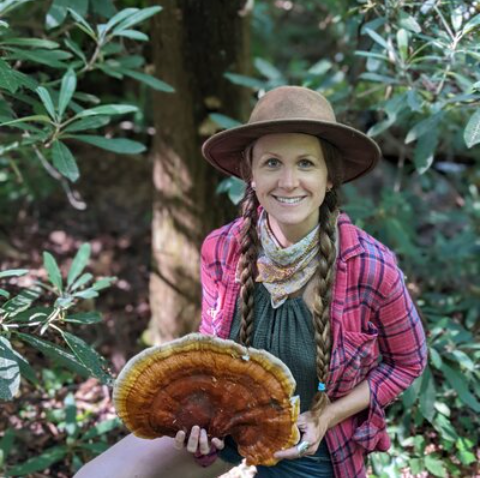Our great-great-grandmothers and beyond passed down basic yet powerful knowledge: how to use plants to heal and nourish. It’s time to remember the simple power of using plants in our homes and to detach from relying on corporations and “experts” to tell us how to be well. How do we weave that ancient plant into our modern lives?
It’s amazing to think that our ancestors used natural medicine to prevent sickness and heal disease until modern medicine took hold about 150 years ago. Today, the health industry brings in billions of dollars a year. Spend any amount of time online, and you can see ads for a supplement that will help you grow your hair or lose weight. Coffee brands are adding medicinal mushrooms into their blends. Yet we also know that true vitality and well-being aren’t found in a pill.
We have it all at our fingertips, yet we still find ourselves searching for answers. Is this all a problem of too many pills and quick fixes? Is it simply about eating more plants? Not quite.
The missing piece for healing
I have worked for nearly two decades to help people find healing. From running an award-winning plant-based restaurant for over eight years to my work as a certified herbalist, the missing thread running through folks who search for health and healing is a shift in lifestyle.
You see, when we view healing as something outside of us, only to set aside when we finally heal, we miss the root of the medicine—the purpose. That purpose is our lives. When our lives become our medicine, everything changes. We take responsibility back into our own homes.
The blue zones of health
Are you familiar with the term “Blue Zone?”. It refers to specific regions of the world where people live longer and have healthier lives. The “Blue Zones” are in Okinawa (Japan), Sardinia (Italy), the Nicoya Peninsula (Costa Rica), Ikaria (Greece), and Loma Linda (California, USA).
When you look at the popularized blue zones and the people who are thriving in those areas of the world, you see a common theme. Their life is full of healing activities and decisions. It’s not just about what they eat. Instead of categorizing their lives and making space for healthy activities in a mostly unhealthy existence, every part of their life supports their thriving.
Connecting to the garden, earth, and nature’s cycles
When I started growing my own food 20 years ago, my life began to change. Instead of watching TV in the evenings, I was in the garden, watering or weeding or simply walking through the gardens admiring the plants. I found myself more aware of the seasons. My movement naturally increased in my daily life.
- Once I harvested my own elderberries, August became elderberry month for our family. We foraged for them daily and spent evenings removing the berries from the stems and freezing them.
- Spring became more than just a season. It became the time when I harvested the dandelion roots as I weed the garden, roasting them to store for the year to come.
- Summertime now brings us into the garden on evenings and weekends as a family, harvesting our tomatoes, squash, peppers, and potatoes.

I noticed that I felt so much better receiving more sunlight through my added time outside. My body felt stronger and more limber. Our dinner plates often reflect our harvests, including potatoes, garlic, and onion in the wintertime, tomatoes, peppers, fresh greens in the summer, squash in the fall, and wild greens in the spring. There is a very real physical connection to our food and to our daily lives.
Is this connection and lifestyle something you are interested in or even perhaps dreaming of?
I’ve written about many of the ways plants help us as medicine.
In 2019, I created a program to help people integrate plants and natural healing into their daily lives. My goal as a “Medicine Woman” was to provide a practical and intuitive guide to making a deep lifestyle shift to:
- Make daily dishes that layer with the medicinal benefits of plants and herbs!
- Make your own herbal remedies and plant-based medicine
- Grow (even some of) your own food and medicine using simple permaculture practices
Called Medicine Woman, it is now a seasoned online program with hundreds of students! We offer a library of now over 170 video lessons (and always growing) as well as monthly live classes. Uniquely, once you sign up for the program you have lifetime access to the program, with no monthly membership fee.
Most students begin with very little knowledge, so it’s not intimidating. Some of those same students go on to build their own medicine gardens, learn how to heal and prevent sickness in their homes, and even incorporate our curriculum into their school for toddlers.

When you empower yourself with the simple yet profound wisdom of healing with even just a handful of plants that grow in your area, you can make healing syrups, tinctures, oils, salves, and so much more. Life becomes full of movement, sunshine, connection with the soil, and a deeper connection to your own body and how to heal.
Using Goldenrod in Dishes
Woven into the Medicine Woman program is the concept of infusing every dish you make at home with plant medicine. It’s easier than it may sound, especially once you become acquainted with the wild plants right outside your door. The program showcases over 55 recipes, including one of the most loved, Goldenrod Butternut Stew.
Goldenrod is beginning to bloom here in the Midwest. She is one of the last flowering wild plants for our pollinators before the cold of winter settles in. Goldenrod also provides valuable medicine for us, including:
- Diuretic: she helps to move water out of the body. This means she’ll make you urinate more frequently, a wonderful aid to moving toxins out of the body
- Anti-microbial: she helps to prevent and fight colds, flu, and other unwanted sickness
- Fever aid: she can help lower a high fever
- Intestinal issues: she comes to our aid when we have gassiness and bloating
- Decongestant /allergy soother: she can help us decongest when we have a stuffy nose, watery eyes, and congestion in the lungs—super helpful with congestion caused by seasonal allergies
- Urinary tract/kidney aid: this is part of her diuretic action. She helps get the kidneys flushing, which also flushes the urinary tract and can help move stagnation from the bladder.
- Wound/burn healing: she is said to be helpful for wound healing and burns. She wouldn’t be my first choice for these issues, but it’s something to note!
Goldenrod can be used very easily in soup and elevate it to a medicinal dish. This is one of our well-loved recipes in the course.

Goldenrod Butternut Stew Recipe
Ingredients:
- 1 butternut squash, peeled and cubed
- 8 cloves garlic, crushed
- 1/2 yellow onion, chopped
- 2 cups goldenrod tea (1/4 cup goldenrod needed)
- 1 cup milk of choice (this can include plant-based milks like cashew or almond)
- 1 teaspoon sea salt
- 2 tablespoons olive oil
Instructions:
- To make your Goldenrod tea, add ¼ cup of fresh Goldenrod flowers to your teapot and pour over your hot water (180 degrees). Steep for 15 minutes and strain.
- Steam your squash, garlic, and onion in your two cups of goldenrod tea. I like to use my wide and shallow metal pan and steam them, sitting right in the tea.
- Once the squash, onions, and garlic are soft, add them to your blender or blend with your immersion blender with your milk, sea salt, olive oil, and 3/4 cup of the steam water. If you are blending, I recommend allowing the ingredients to cool first, as hot liquid in a blender isn’t a great idea.
- Blend until creamy. Warm back up in your pot as needed.

I love serving this with a good crusty bread (gluten-free for me) and some pesto made from our garden basil.
This soup is one of the many medicine-rich recipes we offer in Medicine Woman, which comes with a fun video for those who enjoy learning visually and for entertainment.
The wisdom taught in Medicine Woman isn’t new; it’s ancient wisdom, offered with a fun modern flare. Our ancestors infused the wild nutrients and medicinal benefits of their wild plants into everyday life. When we embrace this lifestyle, we connect back to our roots. Our lives blossom, and the ripples are felt in our homes and communities.
In the program, you will learn:
- How to infuse your dishes with plant medicine, with over 55 recipes
- How to grow your own food
- How to grow your own medicine garden
- How to identify and use over 50 different medicinal plants
- How to make over 35 herbal remedies
- We also include bonus lessons on impactful self-care techniques.
The program includes monthly live classes via Zoom, where we cover a range of topics, including healing specific ailments such as metabolic syndrome, urinary tract infections, leaky gut, and more.
One of our students this year shared that she feels like she has woken up from a dream since she began foraging and harvesting plants to make her own oils, salves, and tinctures. She feels like life has more color and that she is finally IN her life as she had always wanted. I couldn’t have said it better myself, and I wish this for us all.
Doors open for our Fall registration on August 19. I would love to welcome you.















Comments